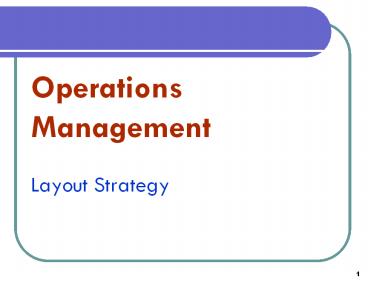Operations Management Layout Strategy - PowerPoint PPT Presentation
Title:
Operations Management Layout Strategy
Description:
Operations Management Layout Strategy * Cycle time calc. On the basis of precedence diagram and activity times given above, the firm determines that there are 480 ... – PowerPoint PPT presentation
Number of Views:1046
Avg rating:3.0/5.0
Title: Operations Management Layout Strategy
1
Operations ManagementLayout Strategy
2
What is Facility Layout
- Location or arrangement of everything within
around buildings - Determines long-run efficiency of operations
- Helps achieve a strategy that supports
differentiation, low cost or quick response
3
Strategic Importance of Layout
- Proper layout enables
- Higher utilization of space, equipment and people
- Improved flow of information, materials, or
people - Improved employee morale and safer working
conditions - Improved customer/client interaction
- Flexibility to change--use small, movable or
modular equipment etc
4
Layout Strategies
- Office layout
- positions workers, their equipment, and
spaces/offices to provide for movement of
communication and information - Retail/service layout
- allocates shelf space and responds to customer
behavior - Warehouse layout
- addresses trade-offs between space and material
handling
5
Seven Layout Strategies
- Fixed-position layout
- large bulky projects such as ships and buildings
- Process-oriented layout
- deals with low-volume, high-variety production
(job shop, intermittent production) - Product-oriented layout
- seeks the best personnel and machine use in
repetitive or continuous production, line
balancing
6
Office Layout
- Design positions people, equipment, offices for
maximum people and information flow, comfort and
safety - Relationship chart used
- Examples
- Banks
- Software company
7
Office Layout Floor Plan
8
Retail/Service Layout
- Design maximizes product exposure to customers
- Decision variables
- Store flow pattern
- Allocation of (shelf) space to products
9
Retail Layouts - Some Rules of Thumb
- Locate high-draw items around the periphery of
the store - Use prominent locations such as the first or last
aisle for high-impulse and high margin items - Distribute power items (items that may dominate
a shopping trip) to both sides of an aisle, and
disperse them to increase the viewing of other
items - Use end aisle locations because they have a very
high exposure rate
10
A Good Service Layout Considers
- Ambient conditions - background characteristics
such as lighting, sound, smell, and temperature. - Spatial layout and functionality - which involve
customer circulation path planning - Signs, Symbols, and Artifacts - characteristics
of building design that carry significance
11
Warehouse Layout
- Design balances between space utilization
handling cost - Similar to process layout
- Items moved between dock various storage areas
- Optimum layout depends on
- Variety of items stored
- Number of items picked
12
Fixed-Position Layout
- Design is for stationary project
- Workers and equipment come to site
- Complicating factors
- Limited space at site
- House, shipyard etc.
13
Process-Oriented Layout
- Design places departments with large flows of
material or people together - Department areas having similar processes located
in close proximity - e.g., All x-ray machines in same area
- Supports process-focused strategy i.e. product
differentiation stategy
14
Emergency Room Layout
15
Product-Oriented Layout
- Facility organized around product
- Design minimizes line imbalance
- Delay between work stations
- Types Fabrication line assembly line
16
Steps in Developing a Process-Oriented Layout
- Construct a from-to matrix
- Determine space requirements for each department
- Develop an initial schematic diagram
- Determine the cost of this layout
- By trial-and-error (or more sophisticated means),
try to improve the initial layout - Prepare a detailed plan that evaluates factors in
addition to transportation cost
17
Cost of Process-Oriented Layout
18
Interdepartmental Flow of Parts
19
Interdepartmental Flow Graph Showing Number of
Weekly Loads
100
3
1
2
50
30
20
100
50
20
10
6
5
4
50
20
Possible Layout 1
21
Interdepartmental Flow Graph Showing Number of
Weekly Loads
30
2
3
221
1
100
50
100
20
50
20
10
6
5
4
50
22
Possible Layout 3
23
Assembly Line Balancing
- Analysis of production lines
- Nearly equally divides work between workstations
while meeting required output - Objectives
- Maximize efficiency
- Minimize number of work stations
24
Assembly Line BalancingThe General Procedure
- Determine cycle time by taking the demand (or
production rate) per day and dividing it into the
productive time available per day - Calculate the theoretical minimum number of work
stations by dividing total task time by cycle
time - Perform the line balance and assign specific
assembly tasks to each work station
25
Assembly Line Balancing Steps
- 1. Determine tasks (operations)
- 2. Determine sequence
- 3. Draw precedence diagram
- 4. Estimate task times
- 5. Calculate cycle time
- 6. Calculate number of work stations
- 7. Assign tasks
- 8. Calculate efficiency
26
Precedence Diagram Example
27
Assembly Line Balancing Equations
28
Cycle time calc.
- On the basis of precedence diagram and activity
times given above, the firm determines that there
are 480 productive minutes of work available per
day. Furthermore, production schedule requires
that 40 units be completed as output from the
assembly line each day. - Cycle time480/4012 minutes per unit
- Min no. of workstations66/125.5 or 6
29
Six Station Solution

